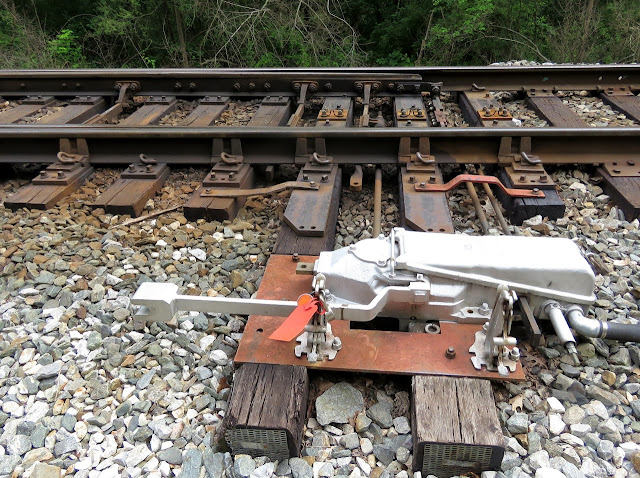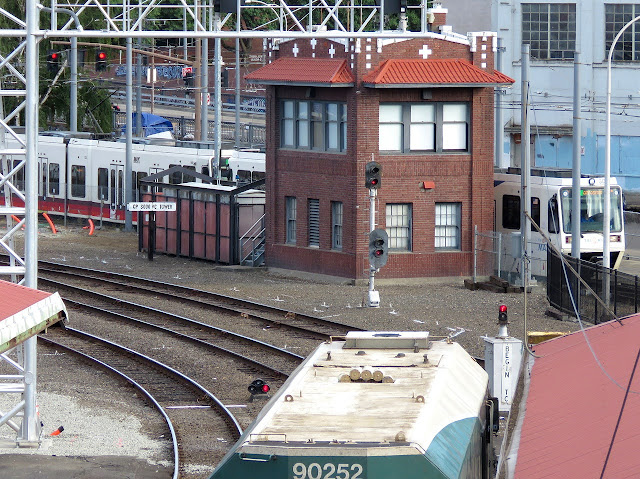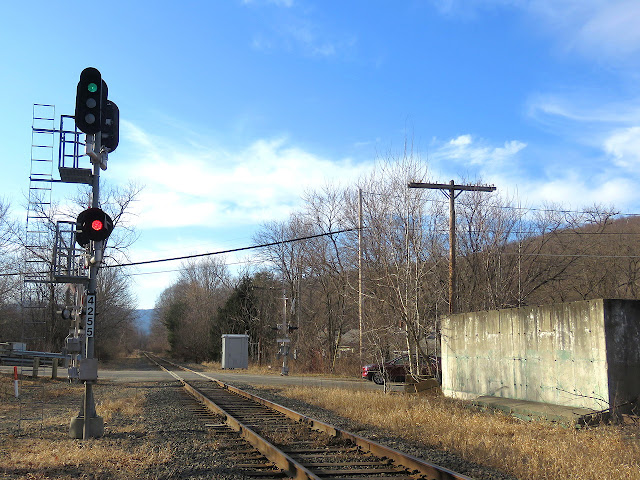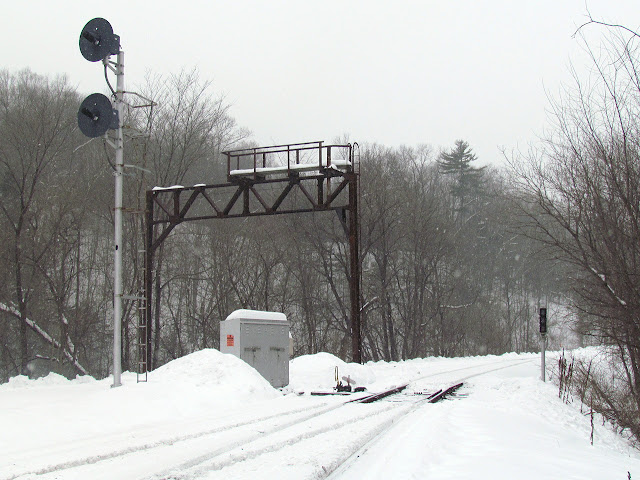A blog devoted to explaining the ins and outs of North American railroad signaling, past, present and future. This blog seeks to preserve through photo documentation the great diversity and technical ingenuity of 20th century signaling and interlocking hardware and technology. Related topics cover interlocking towers and railroad communications infrastructure.
Note, due to a web hosting failure some of the photos and links may be unavailable.
Search This Blog
Friday, August 16, 2024
New Signals at Portland Union Station
Saturday, June 22, 2024
Lock It Up! Electrically Locked Points
Electrically locked switches are the red headed stepchildren of the interlocking world. Not nearly as glamorous as their powered brethren, and rarely ensconced within the safe confined of interlocking limits, electrically locked switches help make North America's efficient bi-directional main tracks possible. For the uninitiated let me clarify that while powered points are also "locked" by something involving "electricity", when I say electrically locked switch, I am referring to a hand throw switch that has some sort of electro-mechanical interlock that prevents operation in the face of an unsafe condition.. E-locked switch hardware is provided by both major North American signaling lineages (US&S and GRS) and in today's post I am going to provide a quick overview of the broad e-locked switch families and how they work.
In the beginning if a railroad didn't want the expense of interlocking a switch with signals via a staffed tower their choices were to assume the risk of trains not being able to get stopped by an improperly set hand throw switch or ensure that all hand throw switches were in the trailing configuration, something that required at least two single direction main tracks. As track circuiting became the norm, operating a hand throw switch could shunt the circuit like any other obstruction, but this wouldn't be much help if an approaching train had already passed the previous block signal.
 |
| Unprotected hand throw switch equipped with a track circuit interrupter. |
The easiest solution is procedural control where the employee shunts the track circuit, waits a proscribed period of time, then throws the switch. However where the railroad desires a bit more assurance than a padlock and watch, the electric switch lock comes into play. The concept is simple, use a solenoid mechanism to prevent switch operation until allowed by the signaling system. This can include direct dispatcher/operator control, like from a lever on an interlocking machine, or conditions such as track circuit occupancy or a rundown timer. In general direct control is the less common of the two as within interlocking limits railroads tend to just pay a bit more for power operated switch machines.
 |
| US&S TM-20 switch stand without an electric lock. |
At this point I want to take the time to clear up a misconception regarding electrically locked switches. Above is the US&S TM-20 hand throw switch stand. It kind of looks like a miniature point machine with wires going into it, a mechanism to work a pipeline connected derail and an extra locking bar. For years I thought this was an electrically locked point machine because it appears on main lines that tend to benefit from electrically locked points. However there is nothing in a TM-20 that provides for locking functionality. The cover on the end is just houses an integrated make/break circuit controller. So while this type of switch stand might look the part, the real e-lock is a bolt on component.
 |
| Abandoned GRS electric lock unit. |
The E-Locks themselves come in two general forms, the plunger style and the pedal style.
Each style is available from both vendor lines, but I want to discuss the pedal style first since it is the one paired with those TM-20 machines I just mentioned. The pedal style consists of a small box, separate from the hand throw point machine, which locks the hand throw switch arm in the desired position. The train crew's padlock holds down a small pedal. Removing the lock allowed the pedal to raise up, energizing the mechanism. In this state a small window displays either a green lamp if the switch is free to move or a red lamp if it is not. If a timer needs to be run, releasing the pedal starts it. Any timers and signaling relays are located in a trackside cabinet. When the lamp is green a second pedal can be depressed to unlatch the hand throw switch arm. Below is an example from the old CP-VO on the former Conrail Selkirk Branch where a direct control pedal type e-lock locks the throw arm of a basic dome type hand throw switch stand.
 |
| Interlocked e-lock hand throw switch stand within CP-VO. |
Here we see a low profile US&S style lock device. Here we see a TM-20 with an SL-25 electric lock attached.
The SL-25 can be even located between the rails in a stand alone configuration and in this case uses a pipeline to lock two TM-20 point mechanisms on either end of an e-locked turnout.
Here we see the GRS answer to the TM-20 with an attached e-lock box. This example is located within the limits of CP-89 on the former Conrail Hudson Line and is released by a "lever" on the dispatcher's interface.
The plunger style is a bit more recognizable due to its more prominent form factor. The plunger lock consists of a little housing, sometimes on a raised pedestal, mounted adjacent to any type of hand throw switch stand. The trainman opens the little door and requests a release by moving a crank type lever from the lock to unlock-request position, similar to a US&S table interlocking machine. This engages the relays and timers in the cabinet and when conditions are safe, a solenoid releases and the crank is able to complete its travel, raising a metal plunger that is physically blocking movement of the switch point rodding in the process. The plunger is either directly below the housing or below the hollow pedestal, if present.
It is common to have both a short and long duration timer with short time (~30 seconds) applying when the main track is unoccupied and the long time (5-13min) applying when a main track train movement is possible. While short and long timers are not exclusive to the plunger type, the plunger type user interface makes them more apparent.
Another feature on the plunger type is the presence of a sealed emergency release button in case something goes wrong with the release logic. Breaking the seal and pressing the button allows for immediate release of the points. On the pedal type e-locks this functionality can be provided by an optional key switch.
 |
| Pedistal mounted plunger lock. Note the housing's similarity to a semaphore signal's. |
These two types of e-locks are the bulk of what one will encounter in North America with the US&S and GRS equipment lines offering both form factors. It's actually pretty simple if you think about it, but if you don't want to take my word for it, here is a video from Mark Clay McGowan that describes the operation of each type in far more detail.
I hope you all found this interesting. I didn't get into the nitty gritty of identifying every exact model of lock, but now that you know what to look for, see if you can spot the slight differences out in the field.
Sunday, January 21, 2024
Hoosac to Hudson: The State of Western B&M Signaling
For years the western end of the old Boston and Maine main line between the Hoosac Tunnel and Mechanicville, NY has been subjected to a highly inconsistent re-signaling programme by the NS-Guilford joint venture "Pan Am Southern". After a recent visitation and Google Earth survey I believe I have determined the exact disposition of B&M signaling between those two locations.
Starting at the Hoosac Tunnel, both CPF-414 and CPF-415 are retain their B&M signaling with tri-lamp searchlights and pulse-code based block state transmission.
Inside the tunnel both ABS signal locations have had their signal heads replaced by modular square LED color lights, but appear to use the same mounting and relay infrastructure.
At the west end of the tunnel CPF-421 is still searchlit and also features an old school intra-interlocking pole line cable bundle as CPF-421 appears to have been a larger pre-CTC interlocking plant.
CPF-423 at the west end of the North Adams CTC siding was unfortunately re-signaled in 2022. This was part of a protracted re-signaling project that was probably cut short by the CSX purchase of the east end of Guilford and the uncertainty about the long term future of the west end.
The split intermediate signals at mileposts 424 and 425 (numbered 144 and 145) were removed and replaced by a single bi-directional mast at the Ashton Ave crossing near MP 425.44. Signal hardware is branded as GE, which is associated with the Landsay company that seems to have taken over the lines of GE/Harmon. The new 425 intermediate may have been intended to replace the holdout signal at CPF-428 as the westbound direction has a fixed lower red lamp, however someone may have thought better of this between when the signal was installed c. 2017 and when it went into service some 5 years later.
The MP 430 intermediate at the old Taconic racetrack along with the MP 432 intermediate were both replaced by a single new mast around MP 431.
This is where things get strange as the next 4 intermediate signal locations at mileposts 435, 438, 440 and 443, are are still B&M searchlit.
At the CPF-445 junction with the Vermont Rail System, the interlocking has been re-signaled and B&M searchlights have been replaced with Unilens searchlights and a Safetran color light dwarf.
However at CPF-448 in Eagle Bridge, the B&M searchlights and signal bridge were decommissioned in favor of LED color lights around 2017. Because the Guilford rail system's particular tastes the project included a westbound bracket mast although the B&M signal bridge was abandoned in place.
Between Eagle Bridge and CPF-464, all the B&M searchlights were removed around 2017 including locations at mileposts 450, 452, 455, 458 and 462. However CPF-464 remains in a 2-head searchlit configuration.
At the other end of the siding CPF-466 also remains searchlit in a 2-head configuration, however the new holdout signal at CPF-467 consists of LED color light masts. At this point the Guilford main line hits the CP searchlights at CPF-468.
I hope this makes things a little clearer for those looking to explore the area. I am kicking myself for not conducting additional expeditions between 2017 when the new masts appeared between MP 423 and 435. I assumed that by 2018 the route would have been re-signaled and rather than risk a wasted road trip I diverted my attention to the Amtrak Hudson Line. This just goes to show that one should verify signal removals instead of mentally writing them off.
Monday, January 31, 2022
The Several Faces of GRS Products
Like the other major North American railroad signaling supplier, General Railway Signaling of Rochester, NY went through a number of corporate ownership changes over the years, eventually becoming part of Alstom in 1998. Unlike the other brand, GRS actually made an effort to update is corporate branding over the years and in many cases the logo was cast into the metal housings of its products.
The classic GRS logo was born in the early 20th century and was consisted of a script monogram type inside a circle, similar in concept to General Electric's logo. Along with the plain text "General Railway Signal" that was used on signal housings, this served GRS well up until the 1970's.
At this point the script logo was decidedly old fashioned and was replaced by a sans serif boxy stylized monogram type. This would be used on documentation up to the Alstom buyout and switch machine castings up through about 2010.
After being purchased by the Sasib Railways Group of Italy in 1989, an updated logo appeared on its new mono-block color light signal that gave the "GRS" monogram some 90's style and included the Sasib logo as well.
After purchase by Alston, the Sasib bit was removed from the molds, but a ghost impression remained.
Ultimately, Alstom felt there was very little value left in the GRS brand and finally has the casting holds changed to read Alstom. However because switch parts are durable and able to be reconditioned, the older logos still show up on motors or reconditioned housings on "new" point machines.
While US&S's many parents have still found no reason to update their castings, there have been all sorts of off brand knockoffs of the venerable M3 point machine, but that is a story for another day.
Friday, July 9, 2021
Searchlight News
I just realized that I had a growing backlog of news items regarding searchlight signals, some of it a little bit old, but still worth highlighting. First up the TWC/ABS territory on the end of Harvard Sub north of Harvard, IL is having its US&S H-2 searchlights replaced along with an associated code-line. There are reports that this will not include CTC, however without any sidings on the track segment the addition of traffic control would be expected. This is the most up to date news so anyone in the area can probably still document the old signals.
Next, the former ATSF diamond in Plainview, TX is also losing its searchlights as of November, 2020, so they might alread be gone.
Next, with the CNW ATC out of service, UP appears to feel free to now alter the interlockings on the Geneva Sub (former CNW main line) between West Chicago and Iowa, which had formerly gotten a reprieve. This will see the replacement of the CNW hallmark oval target searchlights.
Finally I have another case of some signals that got away. In early 2020, the Guilford Rail System retired the signals on the Northern Main Line between Nashua and Manchester, NH due to low traffic and the generally failing state of the system.
While the above diagram doesn't make this abandonment look that bad, there were 6 automatic signal locations and 3 interlockings north of Nashua compared to only 2 automatic locations and 2 interlockings to the south. What's even worse was that I was in the are last Labour Day, however I was fixated on the Lowell terminal area due to the MBTA's Rule 562 project and didn't even realize that the North Main Line was even signaled. I passed within 1200 feet of the retired CPN-28 without realizing it was there only to find out a few months that the signals had been taken down. Not sure what the state of the other locations are, removed or just turned, but its probably still worth checking out.
Sunday, November 22, 2020
The Last New Old Stuff
Typically this blog tends to cover the last examples of one type of signal or tower or whatever. As I have traveled around a different, yet related question has come up. What is the last time some form of classic signaling or signaling equipment was installed new. Now, I know there are many situations where isolated examples of old tech are refurbished and thrown in as a like for like replacement due to a sudden failure. I am talking about identifying the last time someone opened a catalogue and picked out an older piece of equipment for a brand new project. This is interesting as it can create an awareness of when a certain technology or feature might ultimately age out.
Now, I don't have rock solid evidence for most of the following examples, but I am fairly confident in many of them. If any of you have better information please let me know and I'll make a followup post. I am also keeping this limited to North American, or possibly just United States railroads and not transit.
I am going to start off with candidates for the last new interlocking tower built. Yes in theory nothing would be stopping the construction of new towers in the future, but I think the likelihood of that is pretty low. If we limit ourselves to traditional style, stand alone interlocking towers, I would put my money on HAROLD tower in Sunnyside Queens. Built in 1986 and arguably still in service I am unaware of anything newer.
What is unless you count bridge cabins at which point we have the LIRR's LEAD movable bridge built in 1988 and the Henry Ford rail bridge, in LA which I have some evidence of local control, which was built in 1996. However, newest by a significant margin would be the St. Josephs Movable Bridge in St. Joseph Michigan, which was built between 2008 and 2012. 
Of course if you're willing the bend the rules a bit, the PATH installed a new World Trade Center interlocking tower around 2003 and the Staten Island Railroad built their new TOWER A at St. George in 2004. Both are still technically railroads, although operated as rapid transit systems.
The next location wraps up three "lasts" up into one. This would be the last "new" installation of pneumatic point machines (not counting PATH), the last new installation TR type target signals and the last new installation of B&O CPL dwarfs. This would be the Chicago Union Station re-signaling project of 1992 that closed HARRISON ST tower on the south end with control transferred to LAKE ST tower on the north end. Although the CPL dwarfs were largely replaced by LED searchlights barely 10 years later, the pneumatic point machines are currently on their way out and the TR signals are going the way of the CPLs, I believe this project was the last significant use of all three.
Although the interlocking was always pneumatic, it's clear the 1992 project purchased all new parts and components, including pipelines. Like the super power steam of the 1940's, this air plant used the most modern techniques and materials.
The style TR signals appear to be made from some sort of corrosion resistant metal.
CPL dwarfs were also installed at CNW's LAKE ST as drop in semaphore replacements, but like I said that was not a new project and doesn't count. Speaking of B&O CPL,s when was the last time such signals were used in a new project? That would be the 1992/3 CTC projects on the CSX Metropolitan and Capitol subdivisions running out of Washington, DC. These projects, partly funded by the state to increase MARC service, were immediately before the decision was made to switch the former B&O lines to color light signaling, with Viaduct Jct in Cumberland, MD being one of the first examples. I have a 1992 photo of the new CPL's going up on the Met Sub and of course Greenbelt Station and its CPL signaled pocket tracks entered service in 1993.
How about PRR position lights? Well the last large project to use US&S PL-3 type position light lamps was the Secaucus Connection and Newark International Airport Stations on Amtrak's NEC in the 1999-2003 time frame. From then on the PL-3 was dropped from the catalogue and Amtrak went to Safetran position light assemblies, which continue to be installed new to this day.
Alright, let's go a bit more mundane and look at the GRS D Type color light signal employed by the Southern Railway amoung others. The latest major project I am aware of involving D Types was the NJT M&E re-signaling that wrapped up in the 1983/84 time frame. After that the market quickly went to Safetran CLS-10 and CLS-20 signals. I am pretty sure NJT was the last as the Southern had a number of split CLS-10 and CLS-20 mast locations on the Southern Main which would have been installed in the 84-86 timeline before left hand signals were allowed.
For US&S H series searchlights there are a number of good candidates such as the 1986 Amtrak Springfield Line re-signaling, however I think the last H-2/5 searchlight project was the ATSF San Bernardino Sub re-signaling which I think took place in the early to mid 1990's, judging by the construction of the aluminum signal structures.
I'm definitely going more out on a limb here because there is all sorts of stuff I can't properly investigate up in Canad, but the San Bernardino Sub US&S searchlights have a good claim as the last major install. Moving to the GRS Model SA searchlights I have even less evidence, however a solid floor is the Conrail re-signaling of CP-HARRIS with SA searchlights in 1992. If I had to choose something, I would probably choose the Guilford Rail System's Freight Main Line which appears to have gotten a post-1986 makeover, but I do not have high confidence, especially with Canada is taken into consideration.
If I had to speculate on the US&S N series color light signals and their associated "elephant ear" backings I would look to CSX in the late 1990's. Both CSX and the RF&P installed new N series signals in the 1986-1992 time frame with CSX's Abbeville Sub being a specific example from the 1980's. I really don't have enough information to go beyond there, however CSX did install some new elephant ear backings with US&S modular color lights on the A Line and on the old RF&P between RO and AF interlockings. Regrettable, the latter were removed after just a decade of service with the AF rebuild and VRE/Amtrak Alexandria capacity expansion project of the early 2000's.
Well this is what I've been able to come up with for now. If you have any requests for the "last new" install of something I'll give it a noodle, but be aware that I just don't have comprehensive information for the south, west and Canada.











































